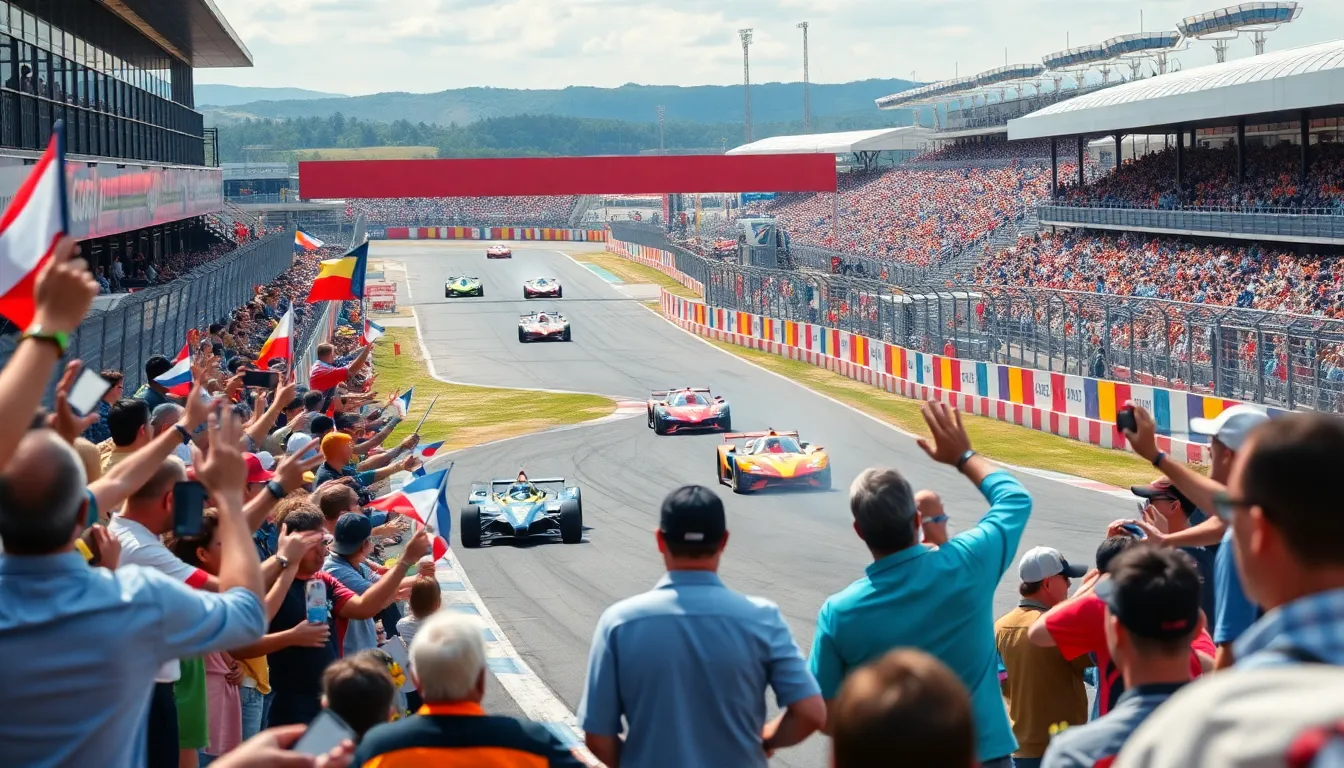Circuit racing tracks are the playgrounds of speed enthusiasts, where rubber meets asphalt and adrenaline hits the roof. Imagine roaring engines, the smell of burning rubber, and the thrill of watching skilled drivers maneuver around tight corners like they’re dancing with their cars. Whether you’re a seasoned racer or just a curious spectator, these tracks offer an electrifying experience that keeps hearts racing and spirits soaring.
Table of Contents
ToggleOverview of Circuit Racing Tracks
Circuit racing tracks serve as dedicated environments for high-speed motorsport events. These tracks feature a variety of designs, including both permanent and temporary layouts tailored for distinct racing disciplines. Popular types of circuit racing include road racing, touring car racing, and sports car racing.
Spectators flock to these venues for the electrifying atmosphere, which blends the intensity of competition with the thrill of speed. Each circuit offers unique challenges, including turns, elevation changes, and straightaways that test driver skill and vehicle performance. Famous circuits, such as the Circuit de Monaco and Silverstone, showcase a blend of tradition and modern technology.
Safety remains a priority at racing tracks. Most circuits incorporate advanced safety features, such as barriers and runoff areas. These elements work to minimize risks while allowing drivers to push their limits. Additionally, circuits often host events for various vehicle types, including single-seaters and motorcycles, catering to a wide audience of motorsport enthusiasts.
Maintenance plays a crucial role in track performance. Regular upkeep ensures optimal conditions for racing, impacting speed and safety. Some circuits even implement innovative safety measures and technology, enhancing the overall experience for drivers and fans alike.
Track facilities include grandstands, pit areas, and support garages to accommodate teams and spectators. These amenities enhance the racing experience, providing comfort and convenience. Overall, circuit racing tracks represent the heartbeat of motorsport, where speed and precision converge in exhilarating competition.
Types of Circuit Racing Tracks

Circuit racing tracks fall into two main categories: permanent and temporary circuits. Each type offers unique features and design elements that cater to different racing styles.
Permanent Circuits
Permanent circuits serve as dedicated spaces for motorsport events, featuring robust infrastructure. Tracks like Silverstone and Circuit de Monaco exemplify these facilities built for endurance and high-speed racing. While they offer consistent conditions for teams, permanent circuits often incorporate advanced safety measures and spectator amenities. These features include grandstands, pit areas, and extensive maintenance routines that enhance the racing experience. In addition, they contribute to the local economy by attracting tourism and major racing events.
Temporary Circuits
Temporary circuits, also known as street circuits, are designed for specific events, often utilizing city streets. These tracks change every year, showcasing diverse environments like those seen in the Formula E series or the Monaco Grand Prix circuit layout. They present unique challenges due to varying surfaces and tight corners, making for exciting racing. While less permanent, temporary circuits can generate significant local interest and engagement. Their flexibility allows organizers to bring motorsport to urban areas, creating a vibrant atmosphere around the events.
Key Features of Circuit Racing Tracks
Circuit racing tracks encompass essential elements that enhance the overall racing experience. These features range from track design to safety measures that ensure both driver and spectator safety.
Track Design
Track design significantly influences a driver’s performance and the excitement of each event. Complex layouts with a mix of tight corners and long straights challenge racers to showcase their skills. Elevation changes add an extra layer of difficulty, testing both car capabilities and driver technique. Famous examples like Circuit de Monaco feature narrow sections, rewarding precision driving. In contrast, tracks like Silverstone offer wider areas, allowing for high-speed overtakes. Varied surfaces, including asphalt and concrete, also impact grip and tire wear, making strategic pit stops critical.
Safety Measures
Safety measures play a crucial role in circuit racing tracks, prioritizing the well-being of everyone involved. Advanced barriers, such as TecPro and tire walls, absorb impacts during accidents, minimizing injuries. Runoff areas designed with gravel or asphalt allow cars to slow down gradually, helping to prevent further incidents. The implementation of strict safety protocols, including track inspections and rigorous driver training programs, ensures compliance with international standards. Medical facilities are strategically located on-site, ready for swift assistance if necessary. These comprehensive measures create a secure environment, enabling drivers to push their limits while maintaining peace of mind for spectators.
Notable Circuit Racing Tracks Around the World
Circuit racing tracks around the globe showcase unique characteristics and unforgettable racing experiences. Here are some of the most notable tracks that define the world of motorsport.
Circuit de Monaco
Circuit de Monaco stands as an iconic venue, hosting the prestigious Monaco Grand Prix. Nestled through the streets of Monte Carlo, the track spans 3.337 kilometers. Its tight corners and elevation changes challenge drivers’ skills and precision. The combination of glamour and high-speed racing creates an electric atmosphere for spectators. Notably, the circuit’s narrow layout demands maximum concentration, with minimal room for error. Over the years, it has become synonymous with luxury and motorsport excellence. Drivers like Ayrton Senna and Lewis Hamilton have left their mark here, adding to the track’s legendary status.
Spa-Francorchamps
Spa-Francorchamps ranks among the most revered tracks in the world. Situated in Belgium, this circuit stretches over 7 kilometers, featuring a mix of fast straights and challenging corners. The famous Eau Rouge and Raidillon combination tests both courage and car capabilities. Weather conditions often shift rapidly, adding unpredictability to races. Historic events, including the Belgian Grand Prix, attract top talent from various racing disciplines. Legendary drivers have competed on this hallowed ground, earning prestigious victories. Rich in history, Spa continues to excite motorsport fans globally, making it a must-visit for racing enthusiasts.
The Future of Circuit Racing Tracks
Circuit racing tracks are evolving rapidly, embracing advancements that enhance both performance and safety. Innovations in technology and design will shape the racing landscape in the coming years.
Innovations in Track Design
Designing modern circuits involves integrating cutting-edge technology. Computer simulations help engineers create layouts that provide thrilling racing experiences. Enhanced surfaces improve grip, reduce tire wear, and create challenges for drivers. Multi-purpose facilities allow for diverse events, maximizing usage and drawing crowds year-round. Additionally, flexible configurations adapt to various racing formats, enabling tracks to host more competitions. Elevated viewing platforms improve spectator engagement, offering unique perspectives of the race. Tracks now incorporate dynamic safety features like adjustable barriers, ensuring driver protection without sacrificing excitement.
Environmental Considerations
Sustainability is increasingly crucial in circuit racing track development. Green initiatives aim to minimize the environmental impact of motorsports. Utilizing eco-friendly materials for track surfaces reduces carbon footprints. Renewable energy sources, such as solar panels, power facilities sustainably. Rainwater harvesting systems capture runoff, promoting responsible water usage. Planting native vegetation around tracks enhances biodiversity while improving aesthetics. Furthermore, many tracks now facilitate electric vehicle racing, showcasing the shift towards greener alternatives. By focusing on sustainability, circuit racing tracks are paving the way for a responsible future in motorsport.
Circuit racing tracks stand as the pinnacle of motorsport excitement and innovation. They offer a unique blend of speed precision and safety that captivates both drivers and fans alike. With their distinct designs and challenging layouts these tracks push the limits of performance while ensuring a secure environment for all involved.
The evolution of these venues reflects a commitment to enhancing the racing experience through technology and sustainability. As the motorsport landscape continues to change circuit racing tracks will remain at the forefront of thrilling competition and community engagement. Their ability to adapt and innovate ensures that they’ll continue to attract enthusiasts for years to come.



